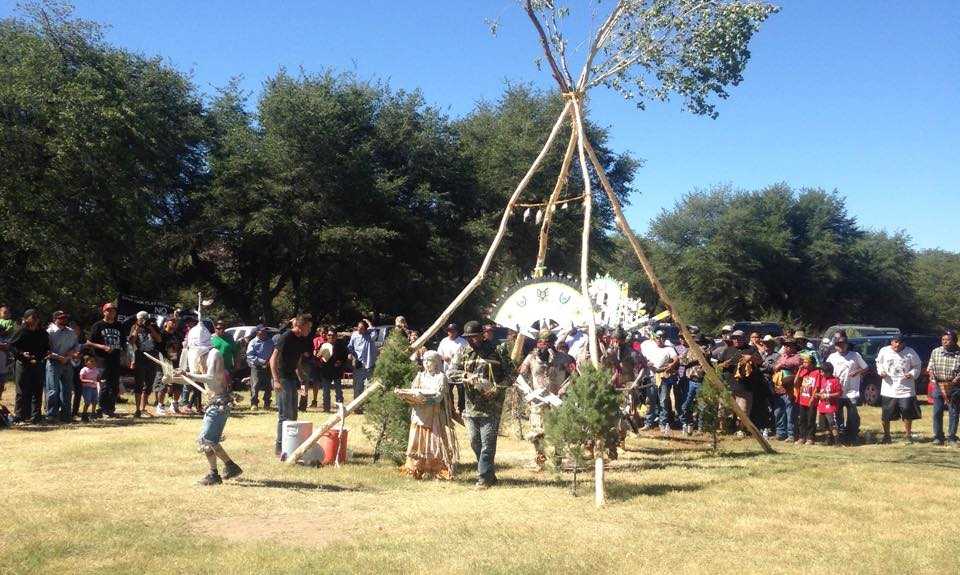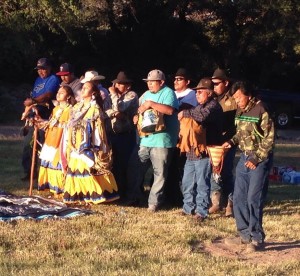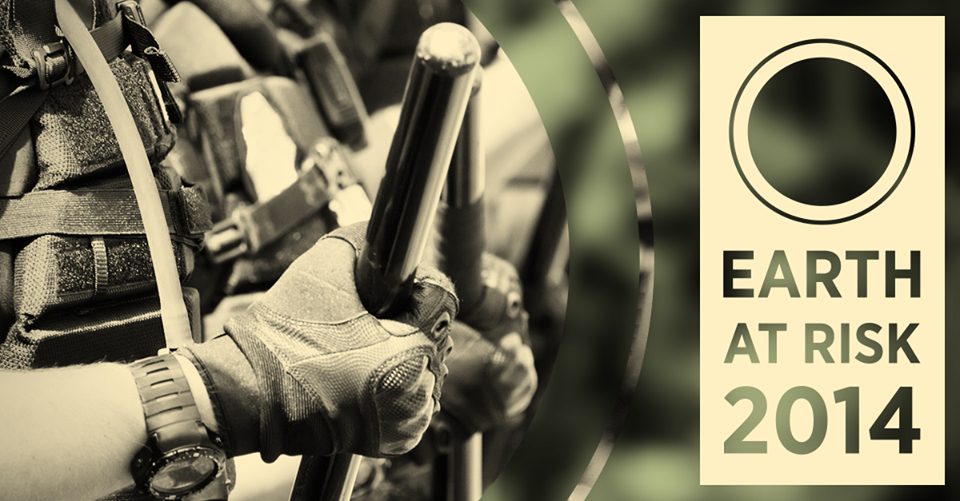
by Deep Green Resistance News Service | Feb 26, 2015 | Biodiversity & Habitat Destruction
By Ashley Michels / Fox 31 Denver
Castle Rock will soon be home to one of the biggest malls in the country, but a local group is trying to push the project back to save the prairie dogs that live there.
The Castle Rock Promenade is scheduled to open by the end of 2015 near I-25 and Meadows Parkway. It will be one of the biggest shopping complexes in the country. While it is expected to bring a major economic boost to the region, several residents have serious concerns.
“I live here because of the open spaces, the topography,” explains long-time resident Linda Vannosdrand. “It is absolutely gorgeous and they are ruining it.”
Several Castle Rock residents stood in protest of the mall Tuesday because the area where it will be built is home to one of the biggest prairie dog colonies in the state. Many worry they will die with the development.
“There are thousands of prairie dogs out here and their lives are just as meaningful as mine is to me,” says prairie dog activist Deanna Meyer.
Protesters are asking Alberta Development Partners to push back their timeline until June.
“There is a way to do it right. The problem with that way is they need to wait until June because all the females are pregnant right now and when they do that they don’t come out of the burrows,” Meyer explains.
Alberta Development has hired a pest control company to begin placing traps over the prairie dog holes. It is not clear if they are being used to exterminate or relocate the animals. Attempts to contact the development company Tuesday were not successful.
From Fox 31 Denver: http://kdvr.com/2015/02/24/group-protests-trapping-of-prairie-dogs-at-huge-castle-rock-shopping-development/

by Deep Green Resistance News Service | Jan 24, 2015 | Colonialism & Conquest, Mining & Drilling
Image Credit: Ryan Martinez Lewis
Deep Green Resistance (DGR) is dedicated to the fight against industrial civilization and its legacy of racism, patriarchy, and colonialism. For this reason, DGR would like to publicly state its support of the San Carlos Apache tribe and the residents of Superior, AZ in the fight to protect Oak Flat from the destructive and unethical practices of foreign mining giant Rio Tinto.
Background
For over a decade the San Carlos Apache tribe and supporters have been fighting against profit-driven attacks on their land by the Superior, AZ based company Resolution Copper (RC), a subsidiary of the international mining conglomerate Rio Tinto. The foreign Rio Tinto is an Anglo-Australian mining company with a shameful history of environmental degradation, human rights abuses, and consorting with oppressive regimes around the globe.
Resolution Copper plans a massive deep underground copper mine in the Oak Flat area using a technique called block caving, in which a shaft is drilled more than a mile deep into the earth and the material is excavated without any reinforcement of the extraction area. Block caving leaves the land above vulnerable to collapse.
Despite this, Resolution Copper is set to acquire 2,400 acres of the federally protected public land in the Tonto National Forest in southeast Arizona in exchange for 5,000 acres in parcels scattered around the state. The 2,400-acre land, part of San Carlos Apache’s aboriginal territory, includes Oak Flat, Devil’s Canyon, and nearby Apache Leap – a cliff where Apaches jumped to their death to avoid being killed by settlers in the late 19th century. The San Carlos Apaches and other Native people hold this land as sacred, where they conduct ceremonies, gather medicinal plants and foods, and continue to build connections with the land. The now public land is held in trust by the federal government and is also used by non-Native nature lovers for hiking, camping, bird watching and rock climbing, and is used for field trips by Boy Scout groups.
Recent Activity
On December 4, 2014 the House passed the National Defense Authorization Act (NDAA), which included the Oak Flat Land exchange as an attachment to the annual must-pass defense bill. This particular version of the land exchange included in the NDAA (the “Southeast Arizona Land Exchange and Conservation Act of 2013”) is the 13th version since the bill was first introduced in Congress in 2005 by former Congressman, Rick Renzi (later convicted in 2013 of multiple counts of corruption, including extortion, racketeering and other federal charges). AZ Senators McCain and Flake, responsible for sneaking this unrelated attachment into the NDAA, subverted the will not only of Native American Tribes, conservation organizations, the Superior Town Council, and others, but the will of the United States Congress which has forcefully rejected the land exchange for nearly 10 years. Flake, who previously worked for Rio Tinto at their uranium mine (co-owned by the Iranian government) in Namibia, acknowledged the bill could not pass the US Congress on its own merits.
Shortly after passing through the House, the NDAA was signed into law by President Obama on December 19, 2014, exactly 5 years after he signed the “Native American Apology Resolution,” a little-noticed expression of regret over how the U.S. had abused its power in the past.
The Southeast Arizona Land Exchange and Conservation Act demonstrates a total disregard for Native American concerns. Resolution Copper has also openly admitted to the fact that their process of mining would create significant land cracking and eventually subsidence. Another grave concern is the permanent damage to surface and groundwater. This mine will deplete enormous quantities of water and pollute it, which will devastate local communities.
Oak Flat is also a rare desert riparian area. Less than 10% of this type of habitat remains in Arizona. The land exchange would allow mining companies to avoid following our nation’s environmental and cultural laws and would bypass the permitting process all other mines in the country have followed. Since this mining would, by design, lead to the complete destruction of the Oak Flat area and potentially impact both Apache Leap and Gaan Canyon, the San Carlos Apache Tribe (along with over 500 other tribes across the country) strongly opposes it and the illegal land exchange.

Call for Solidarity
Indigenous peoples have always been at the forefront of the struggle against the dominant culture’s ecocidal violence. Beneath the violations of US law lies the glaring threat of sacred Apache land being further harmed and colonized. If RC is allowed to follow through with its mining plan, not only would this land be stolen from the Apaches, but it would be rendered unrecognizable.
There is a monumental need for solidarity work to save Oak Flat. The only acceptable action on the part of Resolution Copper is immediate cessation of any and all plans to mine in the ancestral home of the Apache people; anything else will be met with resistance, and DGR will lend whatever support it can to those on the front lines. The time to act is now!
For more information or to lend support, please visit the Arizona Mining Reform Coalition.
**DGR recognizes that members of settler culture are living on stolen land in the midst of a current and ongoing genocide of indigenous people and culture. We encourage those who wish to be effective allies to indigenous people to read our Indigenous Solidarity Guidelines.
References
by DGR News Service | Dec 19, 2014 | Culture of Resistance, Education
Will Falk / Deep Green Resistance
originally published at Generation Alpha
The proper cure requires the proper diagnosis.
On November 22 and 23, the Fertile Ground Environmental Institute offered the proper diagnosis for the ecological crises we all face to over 700 attendees at Earth at Risk 2014. Focusing on environmental and social justice, the conference brought together seemingly disparate voices to weave together diverse perspectives to offer a comprehensive response to global destruction. The keynote speakers were Vandana Shiva, Alice Walker, Chris Hedges, Thomas Linzey, and Derrick Jensen.
Shiva detailed how multi-national corporations like Monsanto and DuPont are using genetically modified organisms (GMO) to undermine local communities’ ability to produce their own food. Walker shared her experiences as a Pulitzer Prize winning author to give an artist’s perspective for the necessity of solidarity with women. Hedges drew upon nearly two decades as a foreign war correspondent to argue for the moral imperative of resistance to topple industrial civilization. Linzey, an attorney, illustrated how citizens come to him asking for help drafting ordinances against fracking and are converted into revolutionary cadre when they learn through the legal system that they do not live in a democracy. Jensen addressed the question “Why are so few of us fighting back?” with an explanation that most of us in this culture are suffering from complex post-traumatic stress disorder.
Time is short and Earth at Risk displayed the appropriate urgency in the face of total environmental destruction. Studies around the world confirm what we feel in our hearts to be true. A recent study by the World Wildlife Fund and the Zoological Society of London shows that half the world’s population of wild animals has died off since 1970. This is consistent with the findings of the University College of London showing insect populations crashing 50 percent in the last 35 years. Human destruction is necessarily implicated in the death of the natural world. We know, for example, dioxin – a known carcinogen – is now found in every mother’s breast milk.
A mere conference is insufficient to stop the madness, but Earth at Risk offered the most complete examination the movement has seen to date offering six panel discussions to go with the five keynote speakers. The first day was devoted to sustainability and featured panel discussions titled Colonization and Indigenous Life, Indicators of Ecological Collapse, and Building Resistance Communities. The second day was devoted to social justice with panels covering Capitalism and Sociopathology; Race, Militarism, and Masculinity; and Confronting Misogyny.
Personal Reflections
In a world gone mad, there are simply too few resisters struggling on. This is one of the reasons we are losing so badly. I left Earth at Risk feeling that patriarchy, colonialism, and capitalism are the most serious threats to a living world. To save the world, alliances must be built on all fronts. While our movements remain relatively small, strength can be maximized in this way.
Earth at Risk’s speakers illuminated opportunities for coalition building and pointed out weak spots in the system ripe for targeting. There were too many highlights to document in one article, but my favorite moments included native Hawaiian filmmaker Anne Keala Kelly’s stinging remarks on the colonization of Hawaii and implorations for real decolonizing help from the mainland during the Colonization and Indigenous Life panel. Fighting for Hawaiian sovereignty would necessarily involve undermining the United States’ military presence there. Hawaii is the site of the United States’ Pacific Command that polices over half the world’s population.
During the Building Communities of Resistance panel, Mi’kmaw warrior Sakej Ward described how native warrior societies protect land bases so they may support the next seven generations. He drew attention to the 500 years of experience North American indigenous peoples have in resisting colonization and offered this experience as a valuable resource.
I was deeply moved by the entire conversation during the Race, Militarism, and Masculinity panel where military veterans Kourtney Mitchell, Vince Emanuele, Stan Goff, and Doug Zachary called on men to topple the patriarchy, stop rape, and support women with actions instead of words.
I attended the conference as a director of the Vancouver Island Community Forest Action Network (VIC FAN) in support of Unist’ot’en clan spokeswoman Freda Huson and Wet’suwet’en hereditary chief Dini Ze Toghestiy who spoke on the Building Communities of Resistance panel about their experiences at the Unist’ot’en Camp. The Unist’ot’en Camp occupies the unceded territory of the Unist’ot’en Clan of the Wet’suwet’en people and is a pipeline blockade sitting on the proposed routes of 17 fossil fuel pipelines in central British Columbia.
My visits to the Unist’ot’en Camp have taught me the strength in connecting the rationales for different social and environmental movements under one banner. It has also taught me how to think strategically. The Camp, as just one of many examples present at Earth at Risk, incorporates principles of indigenous sovereignty and environmentalism to bring activists from both communities together to combat imperialism and fossil fuels. More importantly, perhaps, the Camp demonstrates how a handful of volunteers can effectively neutralize huge, multi-corporate projects by focusing physical strength on chokepoints in industrial infrastructure. From a strategic perspective, the military-industrial complex wrecking the world runs on fossil fuels. Corking the fossil fuels would be a grievous blow to the dominant culture’s ability to continue business as usual.
Additionally, I am a member of the worldwide social and environmental justice organization Deep Green Resistance (DGR) based on the strategy developed by Lierre Keith, Derrick Jensen, and Aric McBay in the book Deep Green Resistance. DGR played a large role organizing the event. Keith brilliantly points out that, “Militarism is a feminist issue. Rape is an environmental issue. Environmental destruction is a peace issue.”
Hearing Kourtney Mitchell explain how his education in pro-feminism enabled to him to overcome the inherently abusive training he received as an infantry soldier in Georgia’s National Guard proved this to me. When Derrick Jensen was confronted for describing the destruction of the natural world in terms of rape and sexual violence and he refused to stop making the connection on grounds that both hinge on men’s perceived entitlement to violation, I understood that radical feminists and radical environmentalists were logical allies. Finally, hearing Richard Manning explain how dire the world’s lack of topsoil has become drove the point home that those of us sick of war would do well to defend the land’s ability to support food.
Finally, the Earth at Risk 2014 website promised to craft “game-changing responses to address the converging crises we face.” The conference successfully fulfilled its promise. The truth is we simply do not have the numbers to mount an effective resistance movement without forming coalitions between groups serious about stopping the murder of the planet and other humans.
I wrote earlier that a conference is insufficient to stop the madness. This is still true, but Earth at Risk 2014 accurately analyzed the world’s sicknesses and gave us a treatment plan to work from. Now, it’s time for all of those fighting so hard in our various causes to link up in solidarity to bring down the patriarchy, stop capitalism, and undermine the colonialism that is killing humans and obliterating the natural world.

by Deep Green Resistance News Service | Nov 17, 2014 | Culture of Resistance, Education
By Fertile Ground
San Francisco, November 22nd-23rd
Global warming. Racism. Sexual Violence. Inequality. War. Species extinction. What are the links between these issues? And how can we move towards victory? An upcoming conference seeks to bring these issues together and answer these critical questions.
“All of the issues we face come from the same culture of extraction,” says event organizer Saba Malik. “They are driven by an urge to exploit. That is what we need to confront.”
Earth at Risk: The Justice and Sustainability Conference is being organized by a grassroots non-profit called Fertile Ground Environmental Institute. The event will feature presentations from radical activists and thinkers on the frontlines of struggle.
Participating speakers and organizations include: Vandana Shiva, Alice Walker, Chris Hedges, Chief Caleen Sisk, Derrick Jensen, Unist’ot’en Camp, Indigenous Women Against the Sex Industry, Thomas Linzey, Sakej Ward, Gail Dines, Dahr Jamail, Iraq Veterans Against the War, Veterans for Peace, Diane Wilson of CODEPINK, and many more.
Most environmental and social justice conferences are driven by corporate agendas and seek appeasement. Earth at Risk is different: it’s a grassroots gathering of people who reject greenwashed solutions and seek revolutionary change.
“Through the green economy an attempt is being made to technologize, financialize, privatize and commodify all of the earth’s resources and living processes,” says keynote speaker Vandana Shiva. “But the growth of the market cannot solve the very crisis it creates.”
Time is short. Indicators of environmental health and cultural morality are heading in the wrong direction. We need all hands on deck, but it’s hard to know where to start. Earth at Risk is a beginning. Join us at the event, and learn the information and the strategies that we need to turn this struggle around.
From Fertile Ground: http://www.fertilegroundinstitute.org/press-release—earth-at-risk-2014.html
Will you be there?
Read Will Falk’s report back on the event, Earth At Risk 2014: Proper Diagnosis

by DGR News Service | Oct 11, 2014 | Education
Our planet is being murdered. Mountains are falling. The oceans are dying. The climate itself is bleeding out and it may be beyond repair. Industrial civilization has entered its thrashing endgame. Technology can’t fix it and shopping—no matter how green—won’t stop it. And we are out of time.
The environmental movement has severely truncated its strategic thinking by insisting on education, consumer choices, and legislative initiatives as the only options for action. None of these can address the scale of the emergency facing our planet.
To save this planet, we need a serious resistance movement that can bring down the industrial economy. Authors Derrick Jensen and Lierre Keith with filmmaker Carson Wright are producing a film that will make the case for that movement. On the Side of the Living starts where the environmental movement leaves off: civilization can never be sustainable and is ultimately incompatible with life. People of courage and conscience are now stranded between moral agony and moral agency: the only certainty is that our one and only home will soon be a bare rock if we do nothing. Within that terrible urgency, the film confronts the possibility—and possible necessity—of principled, militant resistance.
$10,000 will see On the Side of the Living to completion. Go to https://www.indiegogo.com/project/preview/0c27882b to find out more and donate. If you love this planet, please give what you can. Your contributions will help us with film equipment, design, and production costs, as well as transportation expenses so we can deliver aesthetically striking footage with interviews from the movement’s most charismatic leaders.
Those in power are using their control over the culture industry to churn out story after story, book after book, film after film seducing us to forget and encouraging the masses to snuggle back into the warm illusion of civilization. On the Side of the Living combats the lies of those in power. Your support will help us spread our message to a greater audience.
A film supporting principled, militant resistant movement will probably not be overwhelmingly popular with the mainstream population. On the Side of the Living’s message will most likely prevent it from receiving material support from traditional sources of funding like corporations or government grants. But, as so many resistance movements have proven – from the efforts of the women suffragists, to the IRA, and to the Movement for the Emancipation of Niger Delta – a committed group of militant resisters can win.
Funding for On the Side of the Living will be provided by grassroots supporters like you. Support for a serious resistance movement is growing and your support for this film will speed the momentum.
What can you do
– Donate money to make it happen
– share with your networks
– share on social media
– share promotional posters and other media
– organise a fundraiser
Go to https://www.indiegogo.com/project/preview/0c27882b to find out more.





